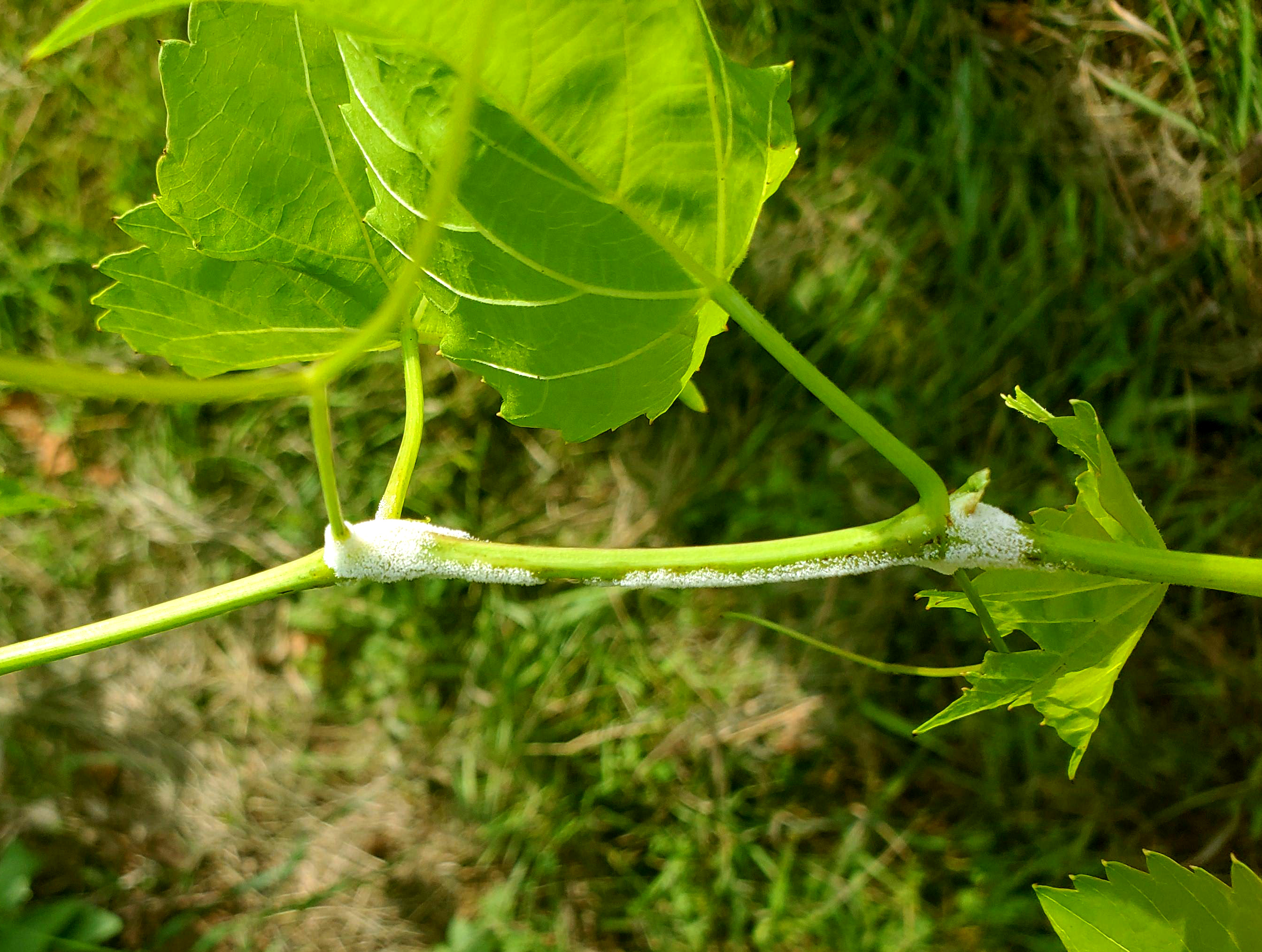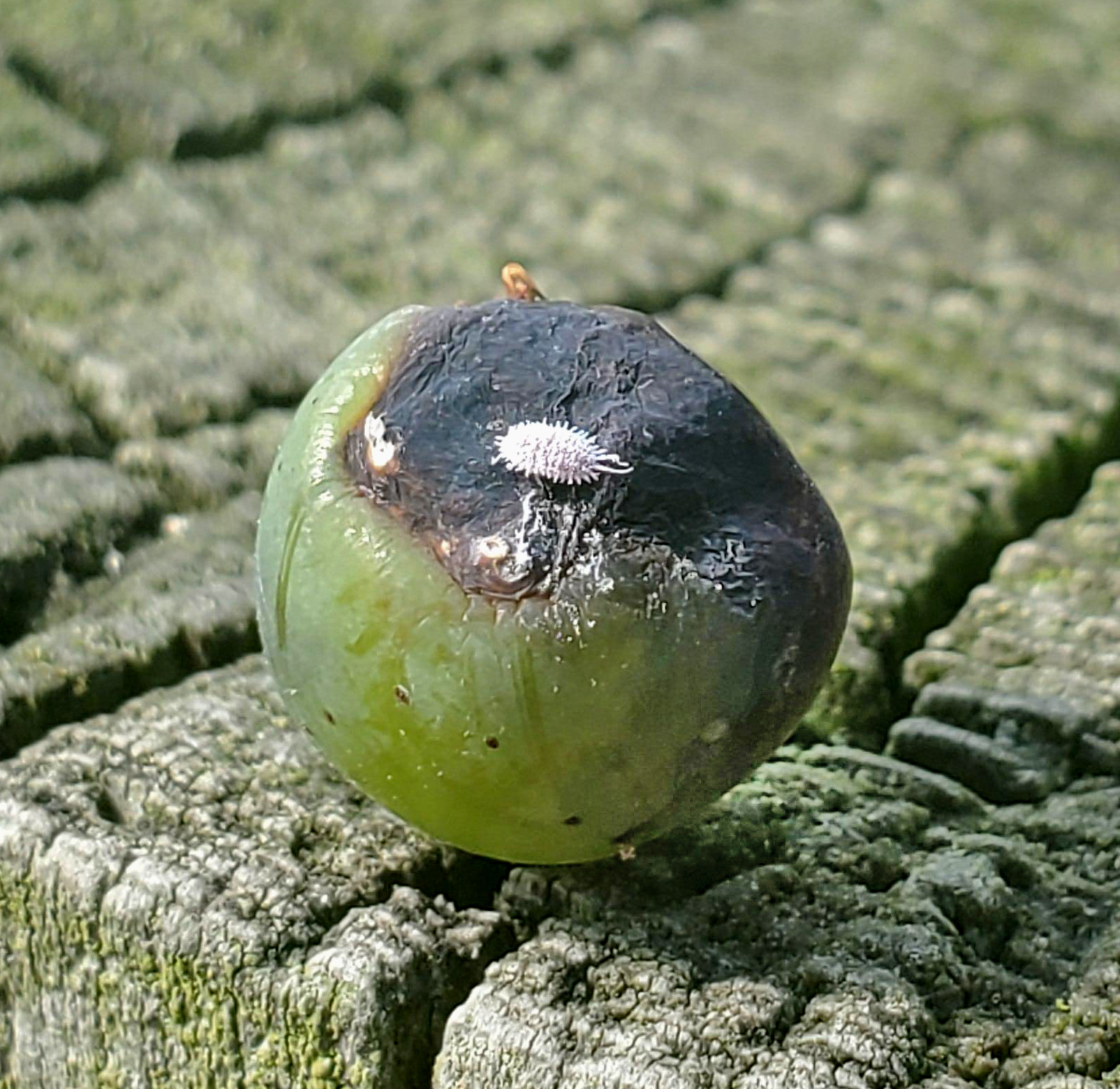Michigan grape scouting report – Aug. 5, 2020
Egglaying from third generation grape berry moth is starting this week in southern vineyards.

Weather
Last week was cooler than the recent warm, humid trend we have been on. Southern portions of Michigan reported highs in the low 80s with mid-70s up north. Much of the fruit growing areas on the west side of the state had highs in the 60s for a day or two earlier this week. A storm system passed through southern Michigan on Sunday, Aug. 2, with scattered rain ranging from less than half to almost 1.5 inches.
The cool, dry weather will continue for the southern grape growing regions this next week, with highs in the mid- to upper 70s climbing into the mid-80s by the first part of next week. Northwestern Lower Michigan is actually predicted to be 5 degrees warmer. The best chance of rain in the forecast is Sunday/Monday.
With the cooler week, we picked up fewer growing degree days (GDD) last week: 125-150 GDD base 50. The southwest region is 415 GDD base 50 ahead of the northwest region.
|
Northwest Michigan GDD summary from March 1 – Aug. 3, 2020 | ||
|---|---|---|
|
Northwest stations |
GDD 50 F |
GDD 47 F from wild bloom (grape berry moth model) |
|
Petoskey (Petoskey) |
1303 |
1106 |
|
Traverse City (NWMHRC) |
1432 |
1219 |
|
Old Mission (Old Mission) |
1372 |
1165 |
|
Avg for NW region |
1381 |
|
|
Average last week |
1254 |
|
|
Southern stations |
GDD 50 F |
GDD 47 F from wild bloom (grape berry moth model) |
|
Benton Harbor (SWMREC) |
1838 |
1645 |
|
Lawton (Lawton) |
1809 |
1564 |
|
Fennville (TNRC) |
1663 |
1452 |
|
Avg for SW region |
1796 |
|
|
Avg last week |
1648 |
|
|
Romeo (Romeo) |
1721 |
1496 |
|
Avg for SE region |
1741 |
|
|
Avg last week |
1594 |
|
Note: Wild grape bloom dates are estimates. See “Mid-season management of grape berry moth” for bloom dates.
Vine growth
Many early hybrids are beginning veraison. Juice grapes and vinifera are not far behind. A small number of brix samples collected this week from vinifera and juice grapes came back at 5-6 brix. Most growers are finished doing cluster zone mechanical leaf removal and shoot positioning on most vinifera varieties. Some are still doing vine hedging. Hedging removes excessive shoot growth from the top and sides of the canopy, preventing shading and entanglement of shoots between rows. This makes it easier for tractors to drive through the vineyard.
Now is the time to accurately estimate vine yields. With a good estimate, you can determine if, when and how much fruit you should remove at thinning time. The Michigan State University Extension bulletin “Predicting Harvest Yield in Juice and Wine Grape Vineyards (E3186)” provides tools to reduce both annual yield and quality variability among years.
Veraison is the time to think about crop thinning to modify vine balance (fruit to vegetative growth). In cool climate regions, crop reduction is required to ripen fruit adequately due to a short season and limited heat units. The intensity of crop thinning depends on the cultivar and vine vigor. Crop thinning has been reported to improve fruit quality including increased sugar accumulation and secondary metabolite concentration (e.g., anthocyanins, phenolics and aroma compounds). Veraison crop thinning is also used to achieve precise final yield goals based on production use of the grapes (grape juice or winemaking).
In northern vineyards, most vinifera are at berry touch or bunch closure. Growers are performing leaf removal while they are tucking shoots in the catch wires. See this chart for grape growth stages.
This is the time of year to collect petiole samples for nutrient analysis. Petiole samples for foliar tissue analysis should be collected from mid-July to mid-August.
Diseases
The disease focus for most grape growers around Michigan is still on downy mildew and powdery mildew management. However, as sugar content increases in fruit, clusters will become vulnerable to botrytis bunch rot and sour rot.
Downy mildew requires wet tissue to develop. Rain is the most commonly associated source for leaf wetness. However, heavy morning dews like those commonly experienced in Michigan this time of year are also good for development. Fungicide sprays at this time will protect against defoliation, but will have limited control over fruit infections. This article provides more information on late season downy mildew control. One important thing to focus on at this time of year is the preharvest interval for some of these products.

Unlike the other grape fungal diseases, powdery mildew doesn’t need leaf wetness to infect, just humid conditions. Even with low ambient humidity, the humidity inside the shaded canopy is higher. Opening up the grape canopy for air movement helps reduce powdery mildew and allows for better spray penetration. Shoot positioning and cluster zone leaf removal can help. For more information on how weather conditions affect powdery mildew development, see “Why some seasons are worse for powdery mildew” from Good Fruit Grower.
Black rot and Phomopsis cluster damage have been seen recently throughout the state, but nothing can be done at this time to effectively manage these diseases.
With several grape varieties at bunch closure, now is an excellent time to control botrytis bunch rot. This is particularly important in vinifera and hybrid grapes. Several strategies contribute to good botrytis bunch rot management. These include opening up the canopy, properly applying fungicides and, using resistant cultivars when possible. Good botrytis control depends on getting good coverage. Fungicide resistance management is important. The most effective products for botrytis are site specific and prone to resistance development. A new Michigan Grape Fact Sheet is now available for Managing botrytis bunch rot for more information about the disease.
Now is a good time to scout your vineyard for suspicious issues related to other stressors. Many of these problems can be abiotic including nutrient related issues and graft incompatibility, but some of the biotic problems can be caused by grapevine trunk diseases or grapevine viruses. If you are interested in taking samples and testing, you can send them to MSU Plant & Pest Diagnostics. Please see these articles on grapevine trunk disease and sampling for grapevine viruses.
A complete list of fungicides for all these diseases with efficacy and other details can be found in the E154 Michigan Fruit Management Guide from Michigan State University Extension. Check the guide for potential phytotoxicity of certain sprays on Concord grapes especially. Phytotoxicity risk is higher with high temperatures and quickly growing vines.
Insects
Note: Thoroughly scout before assuming insects are an economic problem.
In southwest Michigan, we are now finding mature larvae from the second generation of grape berry moth in clusters, and pupae have been seen in clusters and on leaves. Third generation egglaying is expected to start this week for much of southern Michigan: Aug. 2 in Berrien, Aug. 7 in Van Buren, Aug. 9 in Macomb and Aug. 11 in Allegan counties. The larvae emerging from those eggs will start 100 GDD later. In northern Michigan vineyards, second generation egglaying is just starting.
Growers with problems from grape berry moth last year should scout their vineyards and see how sprays applied in July have worked. For high pressure sites, an application to protect from generation three should be applied. For selective insecticides such as Intrepid and Altacor, applications should be timed for egglaying, which will occur at 1,620 GDD from wild grape bloom. For broad-spectrum insecticides, delaying the next application until 1,720 GDD is advised since the young larvae are the target. Since the third generation activity becomes more or less continuous through August and into September, scouting should be used to determine if a follow-up application is required approximately two weeks later.
For more detailed information on choosing the right insecticide, see: August is key time for protecting clusters from grape berry moth. Since grape berry moth attacks berries in the clusters, good spray coverage is critical for control. Be sure to use enough water to penetrate the canopy and cover the clusters. A spreader/sticker can also help cover the confined spaces inside the canopy. Unless clusters are exposed, it will be essential that sprays get up under the layers of leaves, so sprayers should be calibrated and nozzles aligned appropriately.
Potato leafhoppers and grape leafhoppers are at low levels but starting to develop populations, and should be scouted during weekly vineyard visits. This week in unsprayed vineyards at the Trevor Nichols Research Center in Fennville, Michigan, we observed high levels of leafhopper feeding damage on the leaves inside the canopy. So, be sure to look inside the canopy when looking for these insects.
Japanese beetle numbers are dropping and new leaf damage is declining in most sites. Japanese beetles feed between the leaf veins causing a lace-like skeleton on heavily damaged leaves. They seldom feed directly on clusters. Japanese beetles are generally only considered a pest of new vineyards where vines are more sensitive to leaf feeding.
Grape mealybug was found in one Van Buren County vineyard. This insect can feed on various portions of the plant including leaves, shoots and clusters, as well as under trunk bark where they lay their egg sacs. They rarely build up populations high enough to stress vines. They do, however, produce honeydew that can fall onto clusters and support growth of sooty mold. Vineyard should remain vigilant for mealybugs, especially in vineyards with a history of sooty mold on clusters or grapevine leafroll virus symptoms.
Treatment recommendations for these insects can be found in the MSU Fruit Pest Management Guide (E-154).

Upcoming meetings
Grower meetings have moved online. MSU and many other organizations are using Zoom for meetings. Here is more information on Zoom.
The grape grower organization, Parallel 45, is hosting a webinar series this summer. Registration for any/all webinars in their series can be found at 2020 Northwest Michigan Viticulture Webinar Series. At the next scheduled webinar on Aug. 7 from 12-1 p.m., a representative from Enartis will be presenting on "How to improve quality in underripe and compromised fruit with enological tools.”
Related resources
- Michigan grape scouting report – July 29, 2020
- Southwest Michigan Fruit Update – August 4, 2020
- East Michigan Fruit Update – August 4, 2020
- Michigan spotted wing Drosophila update – July 28, 2020
- A Mobile Guide for Grape IPM Scouting in North Central and Eastern U.S.
- Managing grapevine leafroll disease
- Michigan pesticide applicators receive temporary emergency license extension
- Agriculture support labs still open for business, with modifications
- Early season vineyard disease management
- Mid-season management of grape berry moth
- Late season downy mildew control
- Do you suspect grapevine trunk disease in your vineyard?



 Print
Print Email
Email




